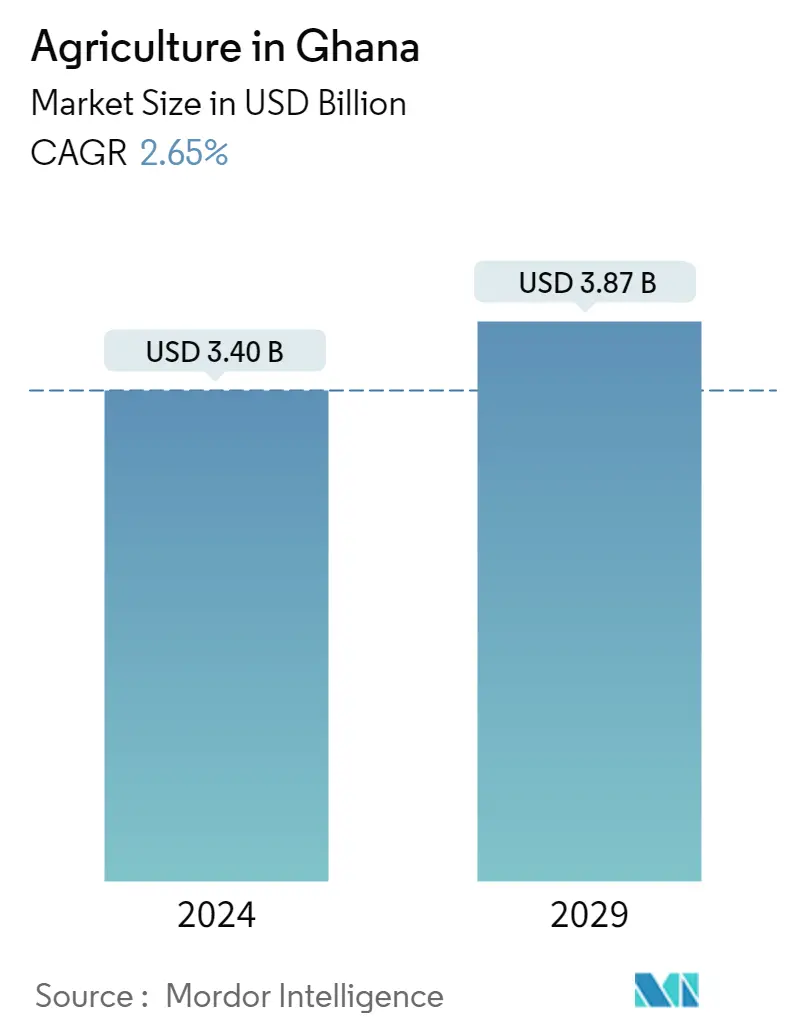Market Size of Agriculture in Ghana

| Study Period | 2019 - 2029 |
| Base Year For Estimation | 2023 |
| Forecast Data Period | 2024 - 2029 |
| Market Size (2024) | USD 3.40 Billion |
| Market Size (2029) | USD 3.87 Billion |
| CAGR (2024 - 2029) | 2.65 % |
Major Players*Disclaimer: Major Players sorted in no particular order |
Ghana Agriculture Market Analysis
The Agriculture in Ghana Market size is estimated at USD 3.40 billion in 2024, and is expected to reach USD 3.87 billion by 2029, growing at a CAGR of 2.65% during the forecast period (2024-2029).
- Ghana has one of the fastest-growing global economies. Agriculture is critical to Ghana's foreign exchange revenues and general economic prosperity. Ghana is gradually moving toward self-sufficiency by increasing agricultural productivity and profitability, increasing access to finance, promoting resilience, optimizing economic inclusion, improving nutrition, and advancing country leadership through evidence-based interventions such as targeting food security interventions in districts in northern Ghana with the lowest poverty and nutrition statistics, promoting the production of diverse, nutrient-dense foods, and advancing country leadership. Agriculture is also collaborating with commercial enterprises, particularly those in the agricultural industry, to develop their operations and enhance their services to meet national and global standards.
- Since agriculture is one of the important contributors to the country's export earnings and a major source of income for a majority of the population in the country, rice is one of the major food staples. However, due to the increased domestic consumption, which is exceeding the domestic production, Ghana imports 66% of the rice consumed. Ghana's government is implementing an import substitution strategy for rice and chicken meat. It has already implemented two significant programs to pay subsidies to farmers producing rice, corn, sorghum, soybeans, and broilers. Other major cash crops of the country include cocoa, oil, pineapple, tomatoes, and fresh vegetables.
- The favorable policies and extended support from the agencies are increasing the development of agriculture. For instance, in 2021, USAID Ghana helped over 63,000 farmers, half of whom are women in northern Ghana, to access agricultural inputs and finance. The same year, it organized 3,000 women to save USD 250,000 through village savings and loan associations. Industrialization and productivity improvement programs are expected to increase the agriculture sector's output, create jobs, and encourage greater participation by the private sector.
Ghana Agriculture Industry Segmentation
Agriculture in Ghana is dominated by traditional smallholder farms. The crops, such as yams, grains, cocoa, oil palms, kola nuts, and timber, form the agriculture base of Ghana's economy. The report defines agricultural products in terms of the end-users. The Ghana agriculture market report analyses the major crops like cereals, fruits, vegetables, and oilseeds along with their production analysis (volume), consumption analysis (value and volume), import analysis (value and volume), export analysis (value and volume) and price trend analysis with supply chain and PESTLE analysis over the forecast period. The report's quantitative analysis will provide Value (USD Thousand) and Volume (Metric Ton).
| Crop Type (Production Analysis by Volume, Consumption Analysis by Volume and Value, Import Market Analysis by Volume and Value, Export Market Analysis by Volume and Value and Price Trend Analysis) | |
| Food Crops / Cereals | |
| Oilseeds and Pulses | |
| Fruits | |
| Vegetables |
Agriculture in Ghana Size Summary
The agriculture sector in Ghana plays a pivotal role in the country's economy, contributing significantly to foreign exchange revenues and providing income for a large portion of the population. The government is actively working towards achieving self-sufficiency by enhancing agricultural productivity and profitability, improving access to finance, and promoting economic inclusion. This is being supported by evidence-based interventions aimed at improving food security, nutrition, and resilience, particularly in regions with high poverty and low nutrition statistics. The sector is also seeing increased collaboration with commercial enterprises to meet both national and global standards. Key crops include rice, cocoa, oil, pineapple, tomatoes, and fresh vegetables, with rice being a major staple despite high levels of imports due to domestic consumption exceeding production. The government has implemented import substitution strategies and subsidies to boost local production of rice, corn, sorghum, soybeans, and broilers.
The demand for high-quality fruits and vegetables is on the rise, driven by the growth of middle-class families in Ghana. The domestic vegetable market is expanding rapidly, with tomatoes, onions, and peppers being significant contributors. The GhanaVeg program aims to establish a sustainable and competitive vegetable sector, targeting high-end domestic and international markets. This initiative is expected to enhance vegetable production, making the fruit and vegetable segment the fastest-growing in the sector. Maize is a crucial crop, providing a major source of calories and accounting for a significant portion of cereal production. The government and private sector initiatives, including the use of hybrid seeds and increased fertilizer usage, are expected to support steady growth in maize production. Recent investments in processing facilities, such as Nestle Ghana's expansion and the inauguration of a maize processing factory, highlight the sector's potential for growth and development.
Agriculture in Ghana Market Size - Table of Contents
-
1. MARKET DYNAMICS
-
1.1 Market Overview
-
1.2 Market Drivers
-
1.3 Market Restraints
-
-
2. MARKET SEGMENTATION
-
2.1 Crop Type (Production Analysis by Volume, Consumption Analysis by Volume and Value, Import Market Analysis by Volume and Value, Export Market Analysis by Volume and Value and Price Trend Analysis)
-
2.1.1 Food Crops / Cereals
-
2.1.2 Oilseeds and Pulses
-
2.1.3 Fruits
-
2.1.4 Vegetables
-
-
Agriculture in Ghana Market Size FAQs
How big is the Agriculture in Ghana Market?
The Agriculture in Ghana Market size is expected to reach USD 3.40 billion in 2024 and grow at a CAGR of 2.65% to reach USD 3.87 billion by 2029.
What is the current Agriculture in Ghana Market size?
In 2024, the Agriculture in Ghana Market size is expected to reach USD 3.40 billion.

